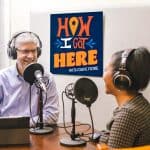The Right Stuff: Equipment Essentials for Beginning Podcasters
The last thing this world needs is another podcast.
At least one that is launched without a sustainable plan for recording, producing and promoting more than a few episodes.
While there are currently more than 450,000 active podcasts on Apple, over half never get past episode seven. In 2019, about 27,000 podcasts stopped releasing new episodes.
But that doesn’t have to be the case.
That same year I launched the How I Got Here podcast to highlight interesting people in Tallahassee, and five years and 64 episodes later, we are still going strong. One reason is that our community is an endless resource of cool people, but I also had a plan to go the distance – assuming anybody wanted to listen.
We are now producing multiple podcasts for clients and have gained some valuable experience along the way.
One of the keys to success is producing a show that sounds good. Some people will say that the content is the only thing that matters, but the truth is that if it is hard to listen to, people will get annoyed and often give up altogether. Having the right recording location and equipment will put your podcast on a solid foundation for long-term success.
The following are my recommendations for an affordable podcast setup similar to what I have used successfully for years. It is simple, dependable and foolproof. The only real risk is you!
Finding a Good Dead Space
If you want your podcast to sound like it was recorded in a professional studio, find a small, interior room with minimal outside noise. A great place if you are a solo podcaster is a walk-in closet. All those hoodies make dreamy sound catchers.
But that may be awkward with a guest, so use a quiet room with some more traditional sound-absorbing items in it.
Think of singing in the shower. You want the opposite of that – in lots of ways.
For example, carpet or rugs on the floor are essential. Bare windows and walls can be problematic, so try using acoustic tiles or thick curtains. If that is not realistic, try bookshelves, blankets pinned to the walls or even piles of pillows to keep the sound from traveling unimpeded through the room.
Creating crevices for the soundwaves to get lost in will keep them from bouncing back and give you a cleaner recording.
Your Setup: Simple is Always Better
Recording a podcast can be as simple as speaking into your phone and uploading it to a free app. But if you are a little more committed to the process, investing in some essential equipment will serve you well.
I could write a blog post about each piece of equipment and why I chose it, but for now I will stick to the basics.
Microphones
The microphones I use today are Rode PodMics. They are a dynamic broadcast microphone that is perfect for podcasting. A dynamic mic picks up sounds in only one direction compared to a condenser mic that records the whole room. You want each mic to record only one person to get clean, editable tracks that are captured separately. This will make editing exponentially easier and produce a better podcast.
Rode PodMics sound professional and are very durable.
Note: These mics use XLR cables (and don’t have USB connections), so they can’t plug into a laptop without another interface. They also require phantom power. I use the Triton FetHead Preamp
The cost is reasonable at $100 per microphone.
Another microphone option is the Audio-Technica ATR2100x-USB. These have both XLR and USB connections and can be connected directly to a laptop. I used these dynamic mics when I first started and still pack them when I record on the road. They are dependable and sound great. Plus the cost is hard to beat at just under $50 each.
Full disclosure—the mics I really want are the Shure SM7Bs. At $400 each, they are a little pricey but a step up in every way. Maybe for 2025!
Digital Recorder
While I have mentioned using laptops a couple times, my preference is to use a digital recorder for the podcast. It is small, made just for this purpose and never restarts or needs updating.
A great option is the Zoom PodTrak P4. It is battery powered (although I always plug it into a USB block), has four microphone inputs, four individual headphone outputs, phone and USB input for remote interviews, sound pads and a 2-in/2-out audio interface.
I primarily use the similar Zoom H6 Recorder in studio, but the PodTrak 4 is less expensive and made just for podcasting. It is my road recorder, and at just $150, it is a smart investment. You can connect both recorders directly to a computer and upload your tracks into your preferred audio editor. Super simple and fool-proof.
Headphones
There is no reason to go crazy with expensive headphones, but having a decent pair is essential to a good recording. I use the MAONO 50MM Drivers Studio Headphones AU-MH601 Over Ear Stereo Monitor. They are around $40 each and sound great. Never use Bluetooth headphones for recording.
That does it for the main elements of your podcast setup. Here are just a few more pieces you will need to complete your studio.
Microphone Stands
Lots of options here depending on your setup (a table and chairs versus sitting on a couch, etc.), but these are the two I use most:
InnoGear Microphone Arm Stand, Heavy Duty Mic Arm Microphone Stand Suspension Scissor Boom Stands
InnoGear Adjustable Desk Microphone Stand, Weighted Base with Soft Grip Twist Clutch, Boom Arm
Microphone Cables
These cables are pretty straightforward. Consider the distance between you and your guests from the recorder. Also think about buying a spare just in case.
Amazon Basics 2-Pack XLR Microphone Cable 15 Foot, Black
Wind Screens
These are crucial to control what audio people call plosives. Those strong “p”s can be brutal! Pro tip: Don’t push them all the way day down over the head of the mic. Leave space to catch even more harsh consonants.
OnStage Foam Ball-Type Microphone Windscreen
Power Adapter
Never depend on batteries. You will never be sorry you read this.
Apple 20W USB-C Power Adapter – iPhone Charger with Fast Charging Capability, Type C Wall Charger
You Can Do This
A podcast can be a powerful tool to explore an interesting subject with others or share the latest tea (my kids told me what that means) on local politics. And while it is truly easy to get started, building something that lasts is a bit more challenging.
Investing in yourself with some basic equipment is a great start.
NOTE: I have provided links to products on Amazon for easy reference. They are not affiliate links. If you can shop locally in person or on the Amazon page for a local business, that is also a great choice.




